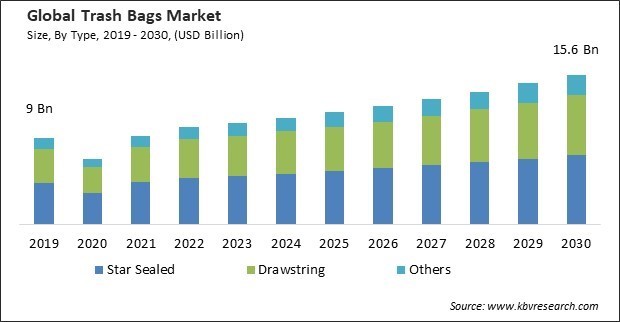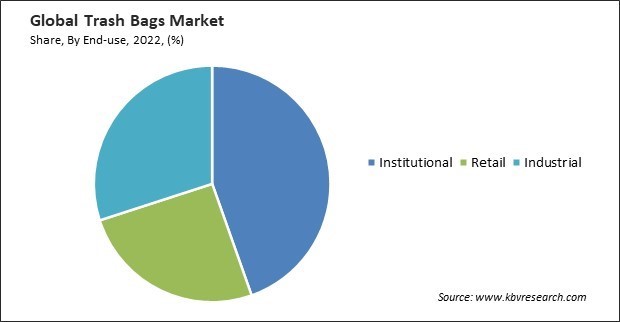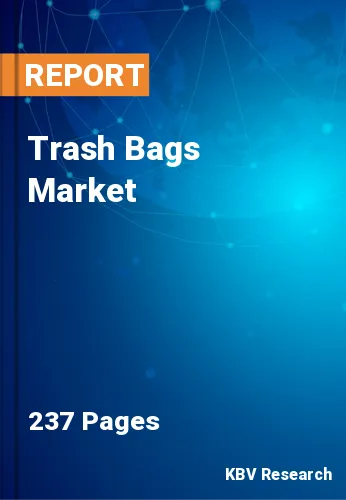The Global Trash Bags Market size is expected to reach $15.6 billion by 2030, rising at a market growth of 5.7% CAGR during the forecast period. In the year 2022, the market attained a volume of 3,079.5 Kilo Tonnes, experiencing a growth of 5.3% (2019-2022).
China and India are among the potential markets in the Asia-Pacific region, alongside Australia, Japan, Singapore, and South Korea. Therefore, the Asia Pacific region captured $3,121.9 million revenue in the market in 2022. Asia Pacific is a leader in the exportation of these bags. Population growth, increased construction activities, and a rise in disposable incomes are among the most significant factors driving the region's market growth. These nations offer substantial potential for the continued expansion of the market. Some of the factors impacting the market are growing need for efficient waste containment and disposal solutions, increasing demand for sustainable solutions and implementation of taxes and bans.

The need for efficient waste containment and disposal solutions has a multifaceted impact on the demand for these bags. Factors such as hygiene, environmental sustainability, waste segregation, and regulatory compliance contribute to the continued growth and diversification of the market as a critical component of effective waste management systems. Additionally, growing environmental awareness drives consumers to seek eco-conscious trash bags made from biodegradable, compostable, or recycled materials. Increased knowledge about environmental issues encourages consumers to choose products that minimize environmental impact, leading to a shift in demand toward sustainable trash bags. The expanding awareness of environmental issues is anticipated to contribute to a heightened demand for eco-friendly bags, which would cater to consumers' inclination towards purchasing products that reflect their ecological principles. Hence, the rising concerns about the environment are propelling the growth of the market.
However, Governments impose a per-bag charge on consumers purchasing single-use plastic bags from retailers or supermarkets. Taxes aim to minimize the adverse effects of plastic waste on ecosystems, wildlife, marine life, and overall environmental health. Some regions implement taxes directly on the production, distribution, or sale of plastic trash bags, influencing their supply availability and pricing. Taxes alter consumer behavior, encouraging reusable bags or opting for alternative eco-friendly options, reducing the consumption of single-use plastic bags. While these measures aim to tackle environmental concerns associated with single-use plastics, their effectiveness depends on proper implementation, public awareness, availability of alternatives, and the balance between environmental objectives and socio-economic considerations. Additional regulations, such as the thickness of the bags manufactured, improper dumping, and environmental concerns, are contributing to reducing the usage of plastic bags. Thus, taxes and bans on the consumption of plastic bags are major factors restraining the growth of the market.
Based on end-use, the market is divided into retail, institutional, and industrial. The institutional segment attained the highest revenue share in the market in 2022. Institutions often produce substantial waste daily, including offices, schools, hospitals, and other public facilities. As populations grow and activities in these places increase, so does the amount of waste generated, leading to a higher demand for these bags. Furthermore, institutions prioritize cleanliness, hygiene, and sanitation. Proper waste management is crucial to maintaining these standards and using these bags is a fundamental part of this process. The emphasis on cleanliness necessitates a constant supply of the bags.

On the basis of type, the market is segmented into drawstring, star sealed, and others. In 2022, the drawstring segment acquired a substantial revenue share in the market. Drawstring trash bags feature built-in drawstrings that enable easy closure and secure bag tying, simplifying waste disposal and handling. Users find drawstring closures more convenient than tying knots, especially for larger or heavier loads of waste. Drawstring closures aid in securing the bag tightly, minimizing exposure to unpleasant odors, and preventing spills or leaks, which is especially beneficial in containing kitchen waste or organic materials.
| Report Attribute | Details |
|---|---|
| Market size value in 2022 | USD 10.2 Billion |
| Market size forecast in 2030 | USD 15.6 Billion |
| Base Year | 2022 |
| Historical Period | 2019 to 2021 |
| Forecast Period | 2023 to 2030 |
| Revenue Growth Rate | CAGR of 5.7% from 2023 to 2030 |
| Number of Pages | 237 |
| Number of Tables | 510 |
| Quantitative Data | Volume in Kilo Tonnes, Revenue in USD Billion, and CAGR from 2019 to 2030 |
| Report coverage | Market Trends, Revenue Estimation and Forecast, Segmentation Analysis, Regional and Country Breakdown, Porter’s 5 Forces Analysis, Company Profiling, Companies Strategic Developments, SWOT Analysis, Winning Imperatives |
| Segments covered | Type, End-use, Region |
| Country scope |
|
| Companies Included | Berry Global Group, Inc., Cosmoplast Industrial Company L.L.C. (Harwal Ltd.), The Clorox Company, Novolex Holdings, Inc. (Apollo), Four Star Plastics, International Plastics, Novplasta, s.r.o, Inteplast Group, Poly-America, L.P. and Reynolds Consumer Products LLC |
| Growth Drivers |
|
| Restraints |
|
Region-wise, the market is analyzed across North America, Europe, Asia Pacific, and LAMEA. The Europe region generated the highest revenue share in the market in 2022. The market in Europe is experiencing growth due to various factors, including increased environmental awareness, technological innovations, regulatory support for sustainable practices, evolving consumer preferences, expanded retail distribution channels, and corporate initiatives toward sustainability. As the demand for eco-friendly and high-quality bags continues to rise, manufacturers are investing in research, innovation, and the production of environmentally responsible solutions, driving the overall growth of the market in the region.
Free Valuable Insights: Global Trash Bags Market size to reach USD 15.6 Billion by 2030
The market research report covers the analysis of key stake holders of the market. Key companies profiled in the report include Berry Global Group, Inc., Cosmoplast Industrial Company L.L.C. (Harwal Ltd.), The Clorox Company, Novolex Holdings, Inc. (Apollo), Four Star Plastics, International Plastics, Novplasta, s.r.o, Inteplast Group, Poly-America, L.P. and Reynolds Consumer Products LLC.
By Type (Volume, Kilo Tonnes, USD Billion, 2019-2030)
By End-Use (Volume, Kilo Tonnes, USD Billion, 2019-2030)
By Geography (Volume, Kilo Tonnes, USD Billion, 2019-2030)
The Market size is projected to reach USD $15.6 billion by 2030.
Increasing demand for sustainable solutions are driving the Market in coming years, however, Implementation of taxes and bans restraints the growth of the Market.
Berry Global Group, Inc., Cosmoplast Industrial Company L.L.C. (Harwal Ltd.), The Clorox Company, Novolex Holdings, Inc. (Apollo), Four Star Plastics, International Plastics, Novplasta, s.r.o, Inteplast Group, Poly-America, L.P. and Reynolds Consumer Products LLC.
In the year 2022, the market attained a volume of 3,079.5 Kilo Tonnes, experiencing a growth of 5.3% (2019-2022).
The Star Sealed segment is leading the Market by Type in 2022; thereby, achieving a market value of $7.3 Billion by 2030.
The Europe region dominated the Market by Region in 2022 and would continue to be a dominant market till 2030; thereby, achieving a market value of $5.3 Billion by 2030.
Our team of dedicated experts can provide you with attractive expansion opportunities for your business.

